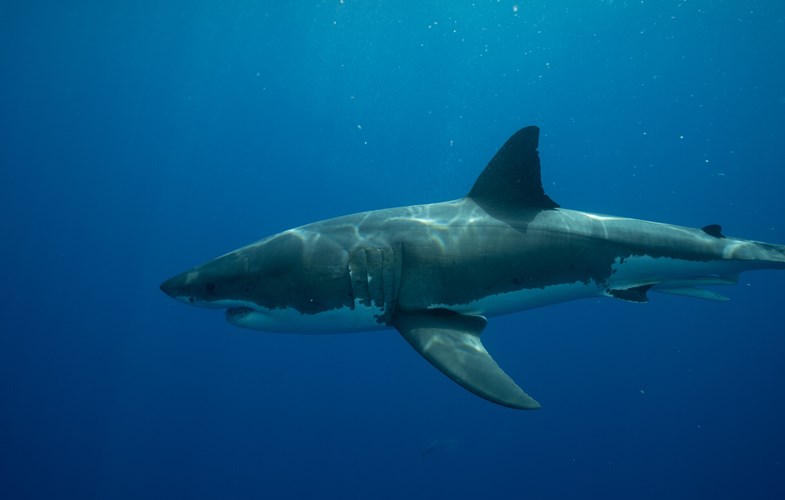

White Shark Chase An international collaboration to find and protect the last remaining white sharks of the Mediterranean Sea.
White Shark Chase
Of all shark species, the white shark is probably one of the most fascinating but, at the same time, most misunderstood and feared predators of our ocean. Although much is still unknown, scientists have studied this species for decades across different locations worldwide and unravelled many mysteries about these animals. South Africa, Australia, and Guadeloupe are just some of the world's most famous hotspots attracting scientists and adventurous tourists.
What surprises many people is that white sharks once roamed the Mediterranean Sea far and wide in high numbers. Historical records and sightings suggested that this species was relatively abundant across the Mediterranean region, but numbers have drastically decreased during the last 50 years due to heavy, industrialized fishing activities. Among the most heavily over-fished regions in the world, the Mediterranean Sea is an extremely dangerous zone for large oceanic predators. As a result, the Mediterranean white shark population is listed as critically endangered by the IUCN – just one category away from extinction.
At the same time, Mediterranean white sharks are arguably the least studied and known population worldwide. Most of what we know is based on opportunistic historical records, whereas targeted research and monitoring to study and effectively protect this species are missing – Where do they migrate? At which depth are they found? Are there seasonal differences? Where are the nursery areas? What do they feed on? How many are left?
To answer these questions, a group of re-known shark scientists, led by Dr. Francesco Ferretti, have initiated this project to find the last remaining white sharks in the Mediterranean Sea. Using historical and recent documented sightings of this species, the team has been able to delimit the search area and identify potential hot-spots to detect these sharks. One of the main areas of interest is the Sicilian Channel, which may include a nursery area for this species, as fishermen reported catches of juvenile and newborn individuals in the past. The most recent sightings of living white sharks originated from this area. Additionally, bluefin tuna migrate in large numbers through this part of the Mediterranean Sea, potentially being one of the main food sources for sharks.
The project is a collaborative effort of multiple institutions and researchers in the US, Europe, and other nations. The group is trying for the first time to actively search for these animals in order to study and protect them. We believe this species needs our urgent protection as catches of large individuals continue to be made. Given the current levels of fishing effort in the region, we need to act quickly in order to save the last remaining individuals and ensure its persistence in the future.
Background information about the project
Project goals
- Identify potential hot-spots of white shark occurrences in the Mediterranean Sea based on historical and recent documentation of sightings and fishery report.
- Confirm potential hot-spots as well as nursery grounds through field research and the use of state-of-the-art technology such as eDNA sampling, BRUVS, drones.
- First-ever detection and recording of the presence of white sharks by a scientific team in the Mediterranean Sea.
- Collect important scientific data and information on their spatial distribution and ecology.
- For the first time in history, deploy a satellite tag to a white shark in the Mediterranean Sea.
- Based on collected data, suggest conservation and management action to ensure the persistence and recovery of the species in the region (e.g., improved fisheries regulations)
Project duration
The project was created to establish a long-term research and monitoring program on the Mediterranean white sharks. The goal is to establish a lasting network of scientists, NGOs, and other parties advancing the understanding of this population and promoting its conservation and recovery.
Location
The project is led by Dr. Ferretti and his team affiliated at Virginia Tech in the USA. All field work is taking place in the Mediterranean Sea.
SharkPulse
SharkPulse – a website and mobile application dedicated to the collection of shark sightings and pictures around the world. This “Citizen’s Science”-data is extremely valuable for scientists and can, for example, help to identify hot-spots of rare and endangered species.
Scientists
Project leader
- Dr. Francesco Ferretti (Ass. Prof. Department of Fish and Wildlife Conservation, Virgina Tech, USA)
Affiliated researchers
- Taylor Chapple (Stanford University, USA)
- Austin Gallagher (Beneath the Waves)
- Robert Schaellert (Tag-a-Giant/Stanford University, USA)
- Brendan Shea (Virginia Tech, USA)
- Chiara Gambardella (Virginia Tech, USA)
- Jeremy Jenrette (Virginia Tech, USA)
- Stefano Moro (La Sapienza University of Rome/Stazione Zoologica Anton Dohrn, Italy)
- Barbara Block (Stanford University, USA)
- David Curnick (Zoological Society London, England)
- Enrico Gennari (Oceans Research, South Africa)
- Dan Stilwell (Virginia Tech, USA)
- Simone Chesi (Virginia Tech, USA)
- Kobun Truelove (Monterey Bay Aquarium Research Institute, USA)
Sharkproject Support
- Jan Bierwirth - M.Sc. in Applied Marine Ecology and Conservation
Sponsors and collaborating partners
- Virginia Tech, USA
- Center for Coastal Studies, Virginia Tech, USA
- Global Change Center, Virginia Tech, USA
- Stazione Zoologica Anton Dohrn, Italy
- Sharkproject International
- Yachts for Science, UK
- The Explorers Club, USA
- Discovery Channel, USA
- Stanford University, USA
- Beneath the Waves, USA
- Oregon State University, USA
- TAG a Giant, USA
Further information
Here is an overview of interesting publications in the context of the project and Great White Sharks in the Mediterranean:
- Loss of Large Predatory Sharks from the Mediterranean Sea by Francesco Ferretti et al. (2008).
- Abundance and distribution of the white shark in the Mediterranean Sea by Stefano Moro et al. (2019).
- New technologies can support data collection on endangered shark species in the Mediterranean Sea by Filippo Bargnesi et al. (2022).
- Emergent research and priorities for shark and ray conservation by Salvador J. Jorgensen et al. (2022).
- Shark detection and classification with machine learning by Jeremy Jenrette et al. (2022).
Technological aspects
The project uses state-of-the-art technology to maximize the chances of success. The range of methods employed is continuously increasing and although some methods may sound relatively complicated, here are some simplified examples and explanations of approaches that were used during the first two expeditions:
eDNA-sampling
This is a fairly new and upcoming technique scientists use to prove the presence of a certain species. Every organism in the ocean leaves tiny organic traces (e.g., faeces or skin particles) containing the DNA of the species. By simply taking a water sample, researchers can filter the water for these remains and detect and identify DNA-traces using specialized equipment. This technique is especially valuable as it is non-invasive and does not require the active catch or direct sighting of a species to prove its presence.
Regarding the project, this technique was and is one of the major technologies used, helping us narrow down the area for our search and delivering real-time information on how close we are to the sharks.
BRUVS
Baited-remote-underwater-cameras are widely used among shark scientists, giving us important clues to shark distribution and species composition at a certain location. During the first expeditions, long-lines of approx. 1km with cameras and bait attached every 200m were deployed in areas where white sharks were detected through eDNA-sampling and where they were expected.
Deep-water BRUVS
We also deployed deep-water BRUVs in deeper areas closer to the seafloor to better understand the shark’s distribution throughout the water column
The team is furthermore working on additional innovative approaches such as the use of aerial and underwater drones to increase the chances of success.
Project history
2021
- a team of international experts and collaborators was established
- the most promising areas for the initial expeditions were defined based on historical and recent sighting reports
- in 2021, the first-of-its-kind expedition searching for white sharks in the Mediterranean Sea was conducted, which resulted in the first-ever detection of the presence of white sharks through eDNA-sampling
2022
- a follow-up expedition in the Sicilian channel was carried out, and a second expedition in the same year is planned around the Aegean Islands
